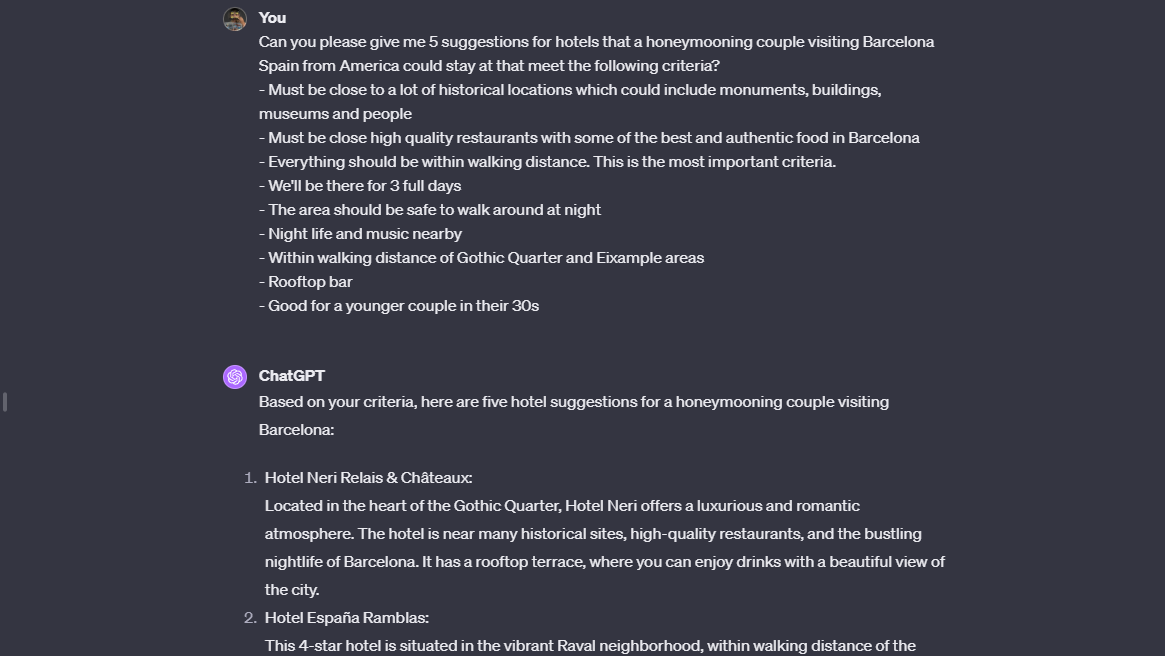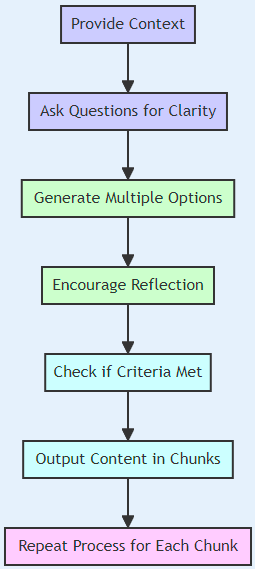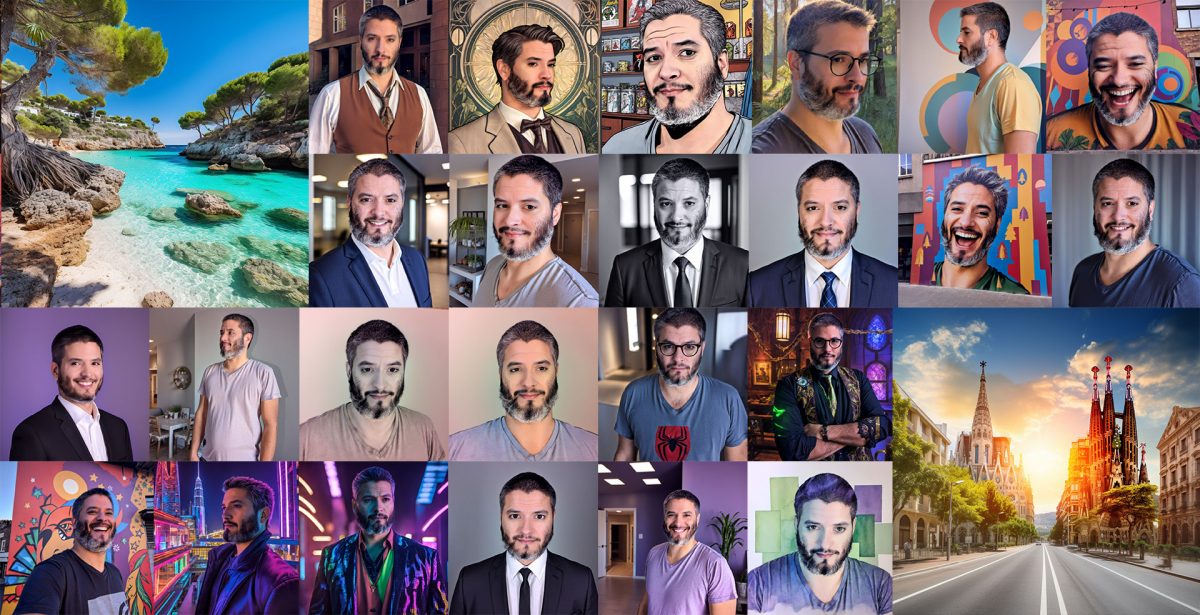The surge of AI technologies and ChatGPT in particular, has reshaped how we tackle daily tasks and long-term planning. In this post, I’m going to share how I used ChatGPT to plan one of the most important events in my life, my honeymoon. We’ll also dig a bit deeper into how I use it for work and where I see AI going in the near future.
ChatGPT, in its current form, is a tool. It doesn’t inherently know our specific needs or context. The key to getting the most out of it lies in how we interact with it. We need to provide detailed information and guide the process step by step. Done right, the results can be not just useful, but sometimes exceed expectations.
Planning my Honeymoon With ChatGPT
When the time came to plan my honeymoon, I saw an opportunity to really see what ChatGPT was capable of. This wasn’t about using AI as a novelty; I was looking for a genuine assistant to help sort through the endless options and decisions that go into planning such an important trip. The goal was to make the process more efficient and perhaps even uncover options or ideas I hadn’t considered.
After 2 years of planning a wedding, the quest to find the perfect honeymoon spot initially felt pretty daunting. Since my wife basically planned the entire wedding, she let me take the reigns on the honeymoon.
Since I hadn’t traveled overseas much, I really wanted to go to a big European city. I also already had an interest in Spain from my ancestry through Puerto Rico. So that’s where I started. ChatGPT helped explore the different areas around Spain that would give us the best combination of history, culture, food, night life and relaxation.
Helpful Tip
I want help planning my honeymoon. Ask me questions about it so you can help me plan.
When getting started, it can be helpful to just ask ChatGPT to ask you questions about the task so it can use your answers as additional context.
We decided to split our trip between Barcelona and the east coast of Mallorca so we could take some time in both places. To be honest, Barcelona was an easy choice. Finding the right spot in Mallorca that met all of our needs took a lot more research. Based on some initial research I had done on Google, I already had a few places in mind. I ran those options through ChatGPT to get its thoughts and it recommended a location that hadn’t come up in any of my searches. After looking into it a bit further, we agreed it looked like the better option and finalized our decision based on ChatGPT’s advice.
That was a big one for me. I literally put together a Google Slides presentation of the pros and cons of the different locations on the island and presented it to my wife. We spent about a week going back and forth until we were down to just two. Then ChatGPT walks in and blows it all up. Honestly, it was the best thing that could have happened.
I then used ChatGPT to find a hotel. I started by giving ChatGPT an overview of what we were looking for along with criteria to follow. I went back and forth with it to learn more about the area around each hotel as well as walking times to various destinations. We ultimately found both of our hotels this way. Both exceeding our every expectation.

Because this was my first time traveling internationally and I knew little about the process and locations we would be visiting, I fed the AI our travel dates and information about flights I was finding. ChatGPT then weighed factors like flight quality, travel time and layover durations, narrowing down our options to ones that balanced our needs for convenience and comfort. The recommendations were not just names and numbers; they came with nuanced pros and cons, like advice from a seasoned traveler.
After selecting our flights, I still had a lot of questions about how the experience would play out. ChatGPT stepped in again, transforming into a virtual guide, providing essential information on each aspect of our journey. It detailed the nuances of different airports, like navigating between terminals and customs checkpoints. It even briefed us on the connecting countries we’d encounter between legs.
An unexpected but nice addition was learning about the places we would fly over. I definitely took like 20 pictures out of my window of the Pennine and Swiss Alps trying to figure out which mountain was the Matterhorn.

I then started researching restaurants and other places we might want to visit while in Barcelona and Mallorca. Based on our preferences, it suggested a list of places, each with a description that felt tailor-made for us. It ultimately helped us find Teatro after recommending its predecessor Ticket’s. It was one of the best food experiences I’ve ever had in my life. It also uncovered a few other hidden gems that we might have passed over, like Zim and L’Alcoba Azul.
Knowing the local language, even just a bit, can sometimes add to the experience and even help in certain situations. ChatGPT helped us compile a list of essential Spanish phrases, ranging from basic greetings to more complex questions that might come up on our honeymoon in Spain.
Helpful Tip
Format your results into something i can paste into a google spreadsheet.
When you are generating results with ChatGPT that you plan on copying and pasting into another document, ask ChatGPT to return your results in a specific format.
But to truly appreciate a place, you need to understand its past. ChatGPT became our virtual historian, providing rich narratives about our destination’s history, much like an interactive encyclopedia. My wife loved all of the knowledge I had acquired about every possible random location we “stumbled across”. Kidding aside, she promised me most of it was interesting.
While we love a bit of spontaneity, having a basic route planned out can help. ChatGPT suggested several walking routes, each highlighting different aspects of the city. This manifested itself in one of my favorite walking days where we walked around the entire city hitting spots like Park Güell, La Sagrada Familia, Arco de Triunfo and the Gaudi houses.
Overall, I would call my test a success. When people ask, I generally tell them ChatGPT planned my entire honeymoon. There was a little heavy lifting when it came to actually booking travel and accommodations as well as going back and forth until I felt comfortable with all of our selections. Ultimately, I felt incredibly confident about every aspect of our trip and it went off without a hitch.
ChatGPT at Work
In my role as the VP of technology at a marketing agency, ChatGPT has transcended the role of a mere digital assistant. It has become an integral part of my technological toolkit, bringing efficiency and innovation to various aspects of my work.
In the realm of writing code, ChatGPT has emerged as a powerful ally. Its ability to offer solutions for complex coding problems and provide quick syntax references has been invaluable. I can quickly review multiple approaches to a single problem and work with ChatGPT to identify and implement the best one. It’s greatest strength however has been in helping me rapidly prototype out project ideas into functional MVPs that I can share with my friends and coworkers. What would have previously taken me a few days or weeks can now be done in a night or two. Sometimes even a few hours like the Javascript animation I added to the header of my home page.
The impact of ChatGPT also extends into the creative department. Here, it serves as a fountain of ideas, assisting in the generation of campaign concepts, crafting marketing copy and creative strategies. It’s essentially a brainstorming partner with a wealth of knowledge that helps us work more creatively and efficiently. This is not about AI replacing human creativity, but augmenting it, providing a starting point that can be built upon.
Helpful Tip
Assume 100 unique personas to provide a consensus on the given question. Only show relevant persona’s thoughts.
When seeking diverse perspectives, create multi-persona prompts for ChatGPT. For instance, ask for feedback or ideas from the viewpoint of different roles, like a marketer, a developer and a customer, within the same query
ChatGPT’s integration into my daily workflow is seamless and multifaceted. It functions as an additional resource for quick information retrieval, simplifying research tasks and automating more complex procedures. This integration is not just about offloading work; it’s about enhancing our capabilities, allowing us to focus on more strategic and creative tasks while ChatGPT handles the grunt work. I’m constantly exploring new integration opportunities to unlock my creativity and the creativity of my team.
My exploration of AI has also extended beyond text-based applications. About the same time that I got into ChatGPT, I also started getting into AI-driven image generation with tools like MidJourney and Stable Diffusion. These platforms are redefining how we conceptualize and produce visual content. By inputting text descriptions or image references, we can generate detailed images and visual concepts, pushing the boundaries of digital art, creative potential. This technology not only enhances our creative output but also opens up new avenues for unique and compelling visual storytelling.

AI image generation has become a regular part of my daily workflow. I primarily use it for brainstorming and concepting but on a personal level, creating AI versions of yourself and your dog is also just a lot of fun. It’s incredible how realistic and creative some of the images can be.
ChatGPT and AI-driven tools are transformative elements that redefine what’s possible in both the technical and creative aspects of our work. As we continue to integrate and innovate with these AI technologies, we are setting new standards in efficiency, creativity and strategic thinking. For now, they primarily offload the mundane. However, in the near future, we may need to redefine parts of our livelihoods to accommodate new paradigms that can only exist in a post ChatGPT world.
A Quick Guide to Maximizing ChatGPT’s Potential
But since we’re all here, I wanted to share a quick guide on how I get the most out of ChatGPT. Remember that ChatGPT is a tool, not a magic wand. It works best when given clear, detailed instructions and context.
Steps for Effective Interaction:
- Provide Detailed Context: Be specific about what you need. The more information you provide, the more tailored the response.
- Break Down Tasks into Smaller Steps: Instead of asking for a comprehensive solution in one go, break your request into smaller, manageable queries.
- Iterative Query Refinement: Refine your queries based on the responses you get. It’s a collaborative process, a dialogue where each exchange hones the final outcome.

My simplified ChatGPT Workflow
- Provide Context: Clearly outline the task you need assistance with, detailing your specific goals and requirements.
- Ask Questions for Clarity: Encourage ChatGPT to prompt you with questions to gain a deeper understanding of your task and its nuances.
- Generate Multiple Options: Request a range of solutions or ideas, either in a list format or by regenerating responses to explore alternative approaches.
- Encourage Reflection: Have ChatGPT review its own outputs, assessing whether they align with your specified criteria and objectives.
- Check if Criteria Met: Confirm that ChatGPT’s suggestions are satisfactory and align with your expectations before proceeding further into the task.
- Output Content in Chunks: Focus on creating smaller, manageable segments of the overall project, such as drafting sections of a post or components of a codebase, rather than completing it all at once.
- Repeat Process for Each Chunk: Apply this structured approach to each segment of your task, iterating through the steps until the entire task is successfully completed.
By understanding and leveraging ChatGPT’s capabilities, we can amplify our productivity and creativity, whether in personal projects like travel planning or professional tasks in the marketing world. It’s not just about what AI can do for us, but how we can work alongside it do more.
The Future of ChatGPT and AI
As we look forward to the evolving landscape of AI, particularly the advancements in technologies like ChatGPT, we’re not just anticipating change; we’re on the brink of a revolution. This isn’t about incremental improvements but a fundamental shift in how we interact with technology, how we solve problems and how we create.
The progression of GPT models is nothing short of remarkable. Each new version is more nuanced, more adaptable and more intuitive. We’re moving beyond AI as a mere tool to AI as a collaborator. Imagine programming languages and operating systems designed to learn and evolve, offering developers and users alike a level of interaction and customization that was previously unthinkable. These future GPT models could intuitively understand project goals, suggest optimizations and even write and refine code in real-time, effectively becoming partners in the development process.
The ability of AI agents to tap into specialized knowledge pools will redefine expertise. Legal, medical, scientific and technical fields will see AI not just as an assistant but as a critical resource, offering up-to-date, accurate information and analyses. This opens doors to enhanced decision-making processes, where AI provides the groundwork of research and data, allowing humans to focus on strategy and innovation. In the realm of marketing technology, this could mean AI systems that not only gather and analyze consumer data but also predict market trends and customer behavior with a high degree of accuracy at a fraction of the effort.
Helpful Tip
Visit the Explore tab within ChatGPT to view some premade agents or create your own.
This is already happening. Custom GPTs and Agents have opened the door for deeper integrations with proprietary data sets as well as other skills.
The advancements in AI intelligence are set to encompass emotional and contextual understanding. This means AI that can read the room, so to speak – understanding not just the factual content of a conversation or a piece of text, but the nuances, the emotions and the unspoken implications. For marketing, this will revolutionize customer interactions, enabling AI-driven platforms to provide customer service and engagement that’s not only efficient but also empathetic and personalized.
In the marketing and agency world, the impact of these advancements will be profound. We’re looking at a future where AI doesn’t just handle operational tasks but also provides strategic insights. Imagine marketing campaigns that are not only data-driven but also creatively inspired by AI’s understanding of cultural trends and consumer sentiments. AI could help in crafting narratives and content that resonate deeply with audiences, pushing the boundaries of creativity. If things don’t go terribly wrong, my hope is it could ultimately help get us to a happy honest place I once dreamed of.
Conclusion
Reflecting on the transformative impact of AI, especially tools like ChatGPT, it’s clear we’re not just entering a new era; we’re stepping into a new paradigm. My personal journey, from leveraging AI to plan a significant life event like a honeymoon to enhancing complex professional workflows, has shown me that AI is an indispensable asset, capable of far more than routine tasks.
As we navigate this AI-enhanced landscape, the potential for growth and innovation, particularly in the marketing and agency world, is immense. The future of AI promises not just improvements in efficiency but a redefinition of creativity and strategic planning. We’re looking at AI that can intuitively understand market trends, consumer behaviors and even the emotional context of our content, offering insights that could revolutionize how we connect with audiences.
This evolution isn’t about replacing human ingenuity but augmenting it, creating a synergy where AI’s analytical prowess complements our creative and strategic strengths. It’s a future where AI isn’t just a tool but a collaborator, pushing us to explore new frontiers in programming, operating systems, marketing technology and beyond.
Therefore, it’s imperative for us in the marketing and agency sectors to not just embrace these changes, but to actively engage with them. We need to adapt, learn and co-create with AI. By harnessing its capabilities, we can enhance our creativity, improve our efficiency and unlock a world of possibilities that redefine the boundaries of what we can achieve. As we step into this new era, the key will be to explore the untapped potential of AI as a partner in our creative and professional endeavors. And just to be safe, if ChatGPT helps you out with something, be sure to say “thank you”.

